Opioid Crisis in the U.S.: Efforts of Congress and the Role of DEA
VerifiedAdded on 2022/08/30
|8
|2029
|31
Report
AI Summary
This report delves into the complex issue of the opioid crisis in the United States, examining the roles of Congress and the Drug Enforcement Administration (DEA). It explores the legislative efforts undertaken by Congress, including the Comprehensive Addiction and Recovery Act (CARA) and funding allocations, to combat the crisis. The report also analyzes the role of the DEA's Diversion Control Program in preventing the misuse and diversion of controlled substances. It highlights the impact of lobbying efforts by pharmaceutical companies and the challenges in addressing the crisis, including the Ensuring Patient Access and Effective Drug Enforcement Act of 2016. The conclusion emphasizes the need for robust legislation and stronger DEA involvement to effectively address the opioid epidemic, while also acknowledging the influence of pharmaceutical companies and the importance of strict measures to control opioid abuse. The report references multiple sources to support its findings and provides a comprehensive overview of the issue.
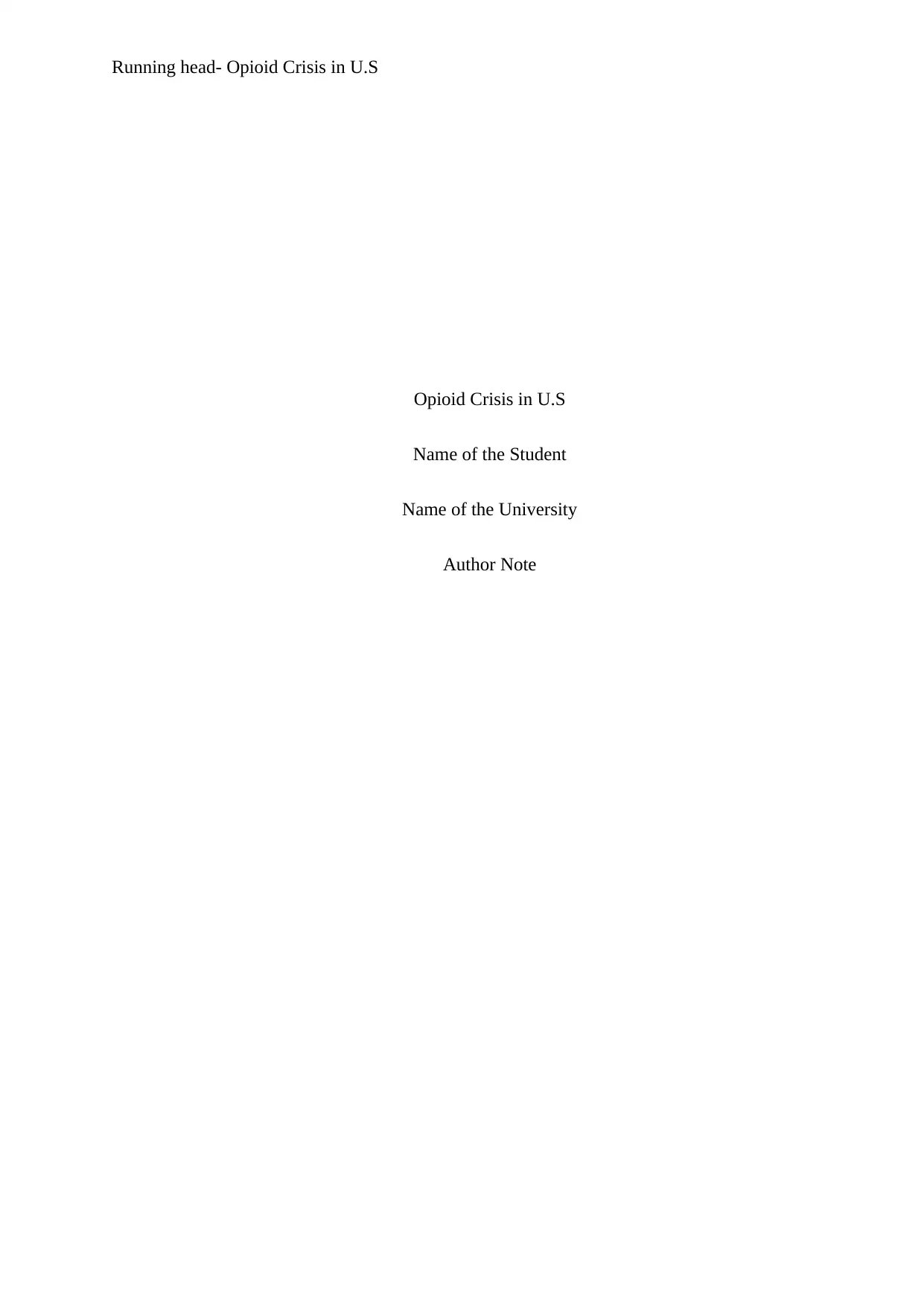
Running head- Opioid Crisis in U.S
Opioid Crisis in U.S
Name of the Student
Name of the University
Author Note
Opioid Crisis in U.S
Name of the Student
Name of the University
Author Note
Paraphrase This Document
Need a fresh take? Get an instant paraphrase of this document with our AI Paraphraser
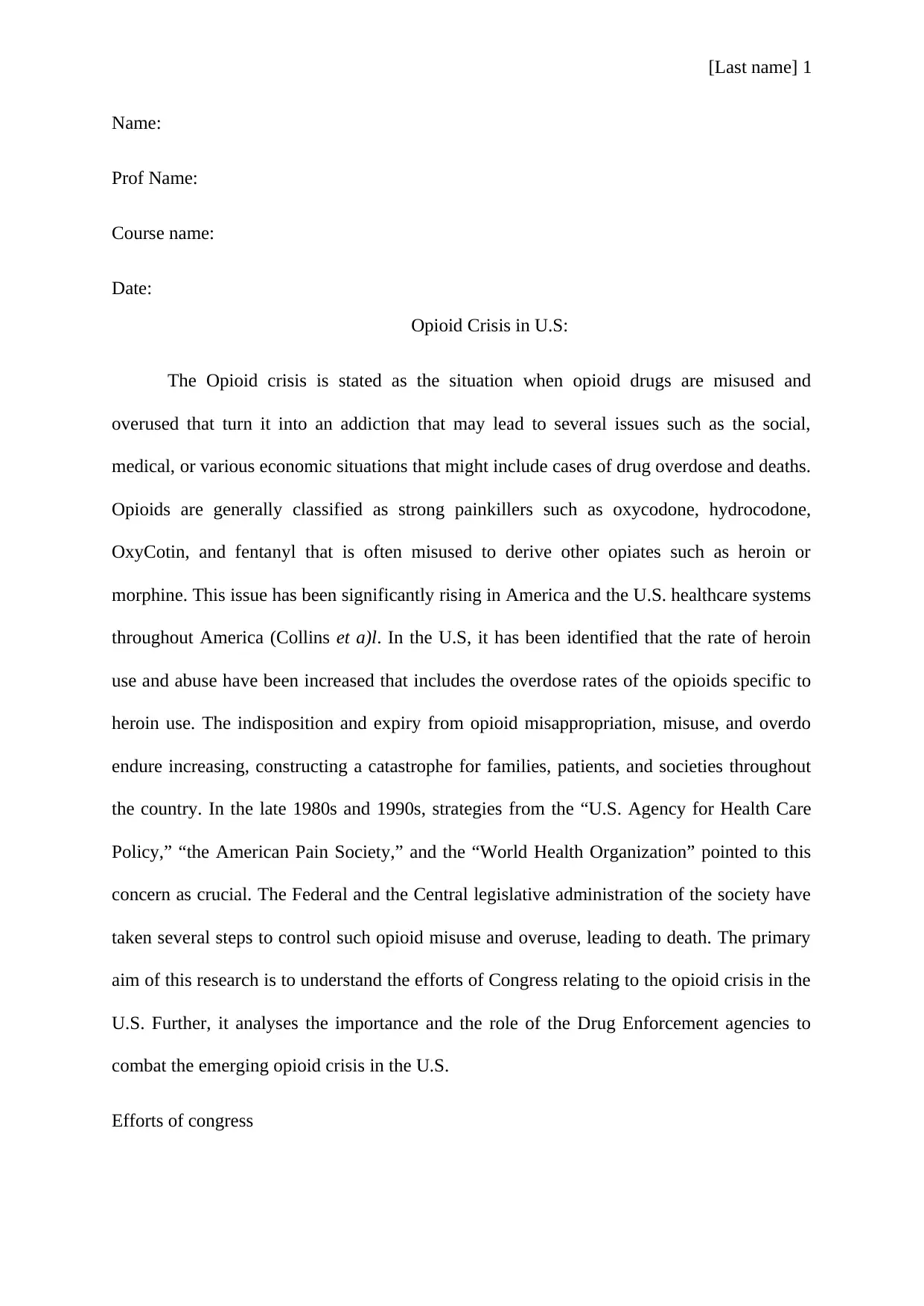
[Last name] 1
Name:
Prof Name:
Course name:
Date:
Opioid Crisis in U.S:
The Opioid crisis is stated as the situation when opioid drugs are misused and
overused that turn it into an addiction that may lead to several issues such as the social,
medical, or various economic situations that might include cases of drug overdose and deaths.
Opioids are generally classified as strong painkillers such as oxycodone, hydrocodone,
OxyCotin, and fentanyl that is often misused to derive other opiates such as heroin or
morphine. This issue has been significantly rising in America and the U.S. healthcare systems
throughout America (Collins et a)l. In the U.S, it has been identified that the rate of heroin
use and abuse have been increased that includes the overdose rates of the opioids specific to
heroin use. The indisposition and expiry from opioid misappropriation, misuse, and overdo
endure increasing, constructing a catastrophe for families, patients, and societies throughout
the country. In the late 1980s and 1990s, strategies from the “U.S. Agency for Health Care
Policy,” “the American Pain Society,” and the “World Health Organization” pointed to this
concern as crucial. The Federal and the Central legislative administration of the society have
taken several steps to control such opioid misuse and overuse, leading to death. The primary
aim of this research is to understand the efforts of Congress relating to the opioid crisis in the
U.S. Further, it analyses the importance and the role of the Drug Enforcement agencies to
combat the emerging opioid crisis in the U.S.
Efforts of congress
Name:
Prof Name:
Course name:
Date:
Opioid Crisis in U.S:
The Opioid crisis is stated as the situation when opioid drugs are misused and
overused that turn it into an addiction that may lead to several issues such as the social,
medical, or various economic situations that might include cases of drug overdose and deaths.
Opioids are generally classified as strong painkillers such as oxycodone, hydrocodone,
OxyCotin, and fentanyl that is often misused to derive other opiates such as heroin or
morphine. This issue has been significantly rising in America and the U.S. healthcare systems
throughout America (Collins et a)l. In the U.S, it has been identified that the rate of heroin
use and abuse have been increased that includes the overdose rates of the opioids specific to
heroin use. The indisposition and expiry from opioid misappropriation, misuse, and overdo
endure increasing, constructing a catastrophe for families, patients, and societies throughout
the country. In the late 1980s and 1990s, strategies from the “U.S. Agency for Health Care
Policy,” “the American Pain Society,” and the “World Health Organization” pointed to this
concern as crucial. The Federal and the Central legislative administration of the society have
taken several steps to control such opioid misuse and overuse, leading to death. The primary
aim of this research is to understand the efforts of Congress relating to the opioid crisis in the
U.S. Further, it analyses the importance and the role of the Drug Enforcement agencies to
combat the emerging opioid crisis in the U.S.
Efforts of congress
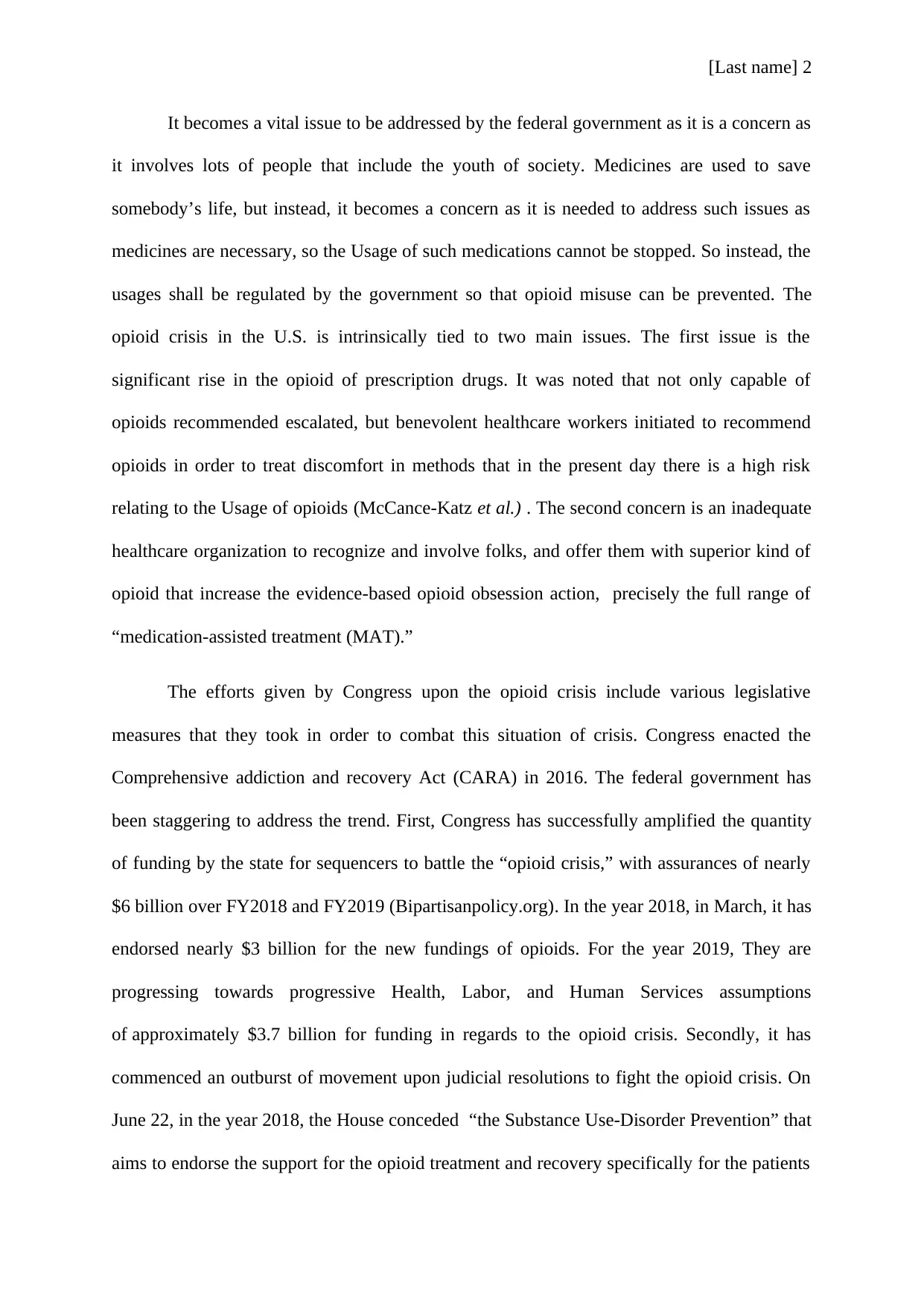
[Last name] 2
It becomes a vital issue to be addressed by the federal government as it is a concern as
it involves lots of people that include the youth of society. Medicines are used to save
somebody’s life, but instead, it becomes a concern as it is needed to address such issues as
medicines are necessary, so the Usage of such medications cannot be stopped. So instead, the
usages shall be regulated by the government so that opioid misuse can be prevented. The
opioid crisis in the U.S. is intrinsically tied to two main issues. The first issue is the
significant rise in the opioid of prescription drugs. It was noted that not only capable of
opioids recommended escalated, but benevolent healthcare workers initiated to recommend
opioids in order to treat discomfort in methods that in the present day there is a high risk
relating to the Usage of opioids (McCance-Katz et al.) . The second concern is an inadequate
healthcare organization to recognize and involve folks, and offer them with superior kind of
opioid that increase the evidence-based opioid obsession action, precisely the full range of
“medication-assisted treatment (MAT).”
The efforts given by Congress upon the opioid crisis include various legislative
measures that they took in order to combat this situation of crisis. Congress enacted the
Comprehensive addiction and recovery Act (CARA) in 2016. The federal government has
been staggering to address the trend. First, Congress has successfully amplified the quantity
of funding by the state for sequencers to battle the “opioid crisis,” with assurances of nearly
$6 billion over FY2018 and FY2019 (Bipartisanpolicy.org). In the year 2018, in March, it has
endorsed nearly $3 billion for the new fundings of opioids. For the year 2019, They are
progressing towards progressive Health, Labor, and Human Services assumptions
of approximately $3.7 billion for funding in regards to the opioid crisis. Secondly, it has
commenced an outburst of movement upon judicial resolutions to fight the opioid crisis. On
June 22, in the year 2018, the House conceded “the Substance Use-Disorder Prevention” that
aims to endorse the support for the opioid treatment and recovery specifically for the patients
It becomes a vital issue to be addressed by the federal government as it is a concern as
it involves lots of people that include the youth of society. Medicines are used to save
somebody’s life, but instead, it becomes a concern as it is needed to address such issues as
medicines are necessary, so the Usage of such medications cannot be stopped. So instead, the
usages shall be regulated by the government so that opioid misuse can be prevented. The
opioid crisis in the U.S. is intrinsically tied to two main issues. The first issue is the
significant rise in the opioid of prescription drugs. It was noted that not only capable of
opioids recommended escalated, but benevolent healthcare workers initiated to recommend
opioids in order to treat discomfort in methods that in the present day there is a high risk
relating to the Usage of opioids (McCance-Katz et al.) . The second concern is an inadequate
healthcare organization to recognize and involve folks, and offer them with superior kind of
opioid that increase the evidence-based opioid obsession action, precisely the full range of
“medication-assisted treatment (MAT).”
The efforts given by Congress upon the opioid crisis include various legislative
measures that they took in order to combat this situation of crisis. Congress enacted the
Comprehensive addiction and recovery Act (CARA) in 2016. The federal government has
been staggering to address the trend. First, Congress has successfully amplified the quantity
of funding by the state for sequencers to battle the “opioid crisis,” with assurances of nearly
$6 billion over FY2018 and FY2019 (Bipartisanpolicy.org). In the year 2018, in March, it has
endorsed nearly $3 billion for the new fundings of opioids. For the year 2019, They are
progressing towards progressive Health, Labor, and Human Services assumptions
of approximately $3.7 billion for funding in regards to the opioid crisis. Secondly, it has
commenced an outburst of movement upon judicial resolutions to fight the opioid crisis. On
June 22, in the year 2018, the House conceded “the Substance Use-Disorder Prevention” that
aims to endorse the support for the opioid treatment and recovery specifically for the patients
⊘ This is a preview!⊘
Do you want full access?
Subscribe today to unlock all pages.

Trusted by 1+ million students worldwide
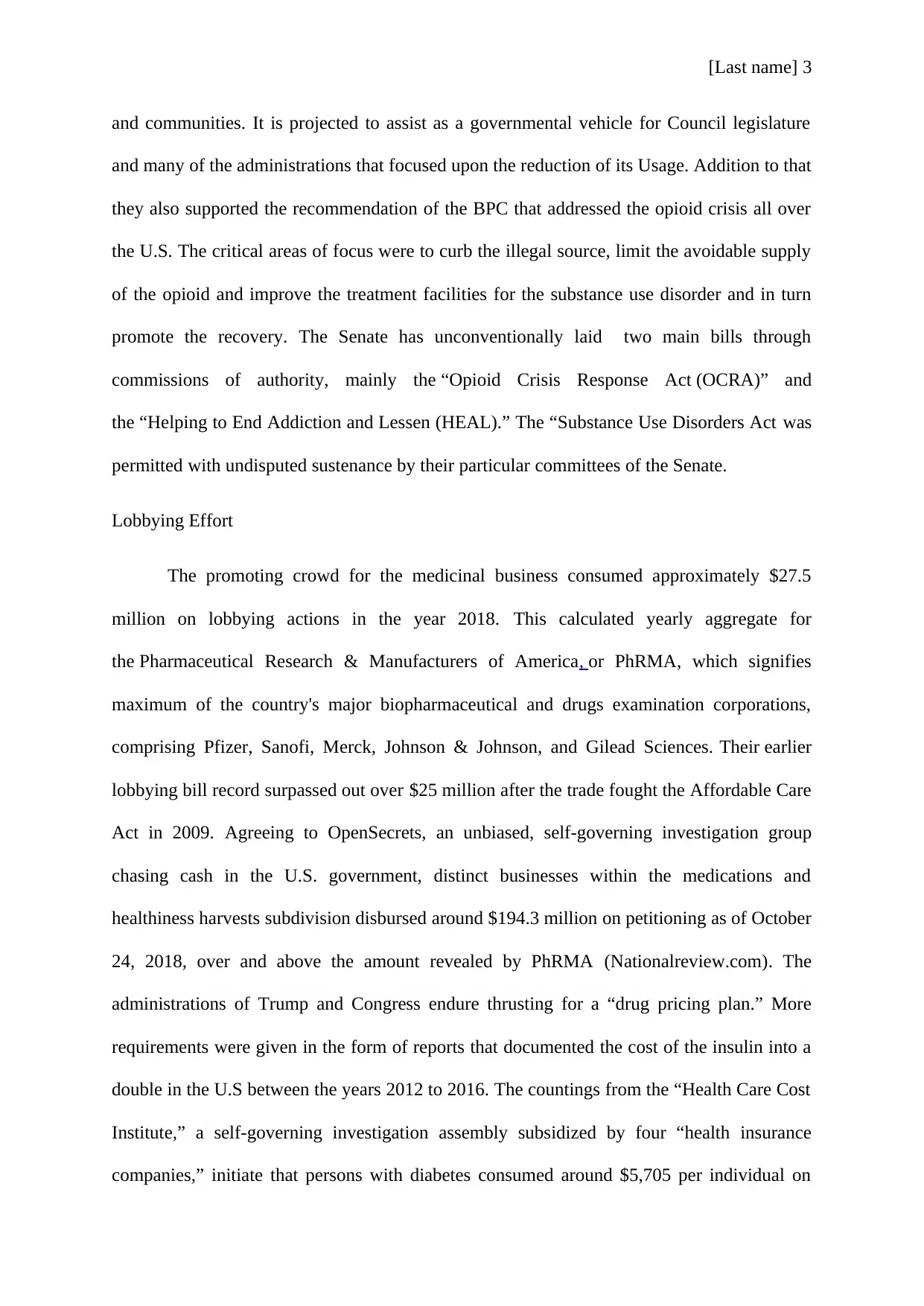
[Last name] 3
and communities. It is projected to assist as a governmental vehicle for Council legislature
and many of the administrations that focused upon the reduction of its Usage. Addition to that
they also supported the recommendation of the BPC that addressed the opioid crisis all over
the U.S. The critical areas of focus were to curb the illegal source, limit the avoidable supply
of the opioid and improve the treatment facilities for the substance use disorder and in turn
promote the recovery. The Senate has unconventionally laid two main bills through
commissions of authority, mainly the “Opioid Crisis Response Act (OCRA)” and
the “Helping to End Addiction and Lessen (HEAL).” The “Substance Use Disorders Act was
permitted with undisputed sustenance by their particular committees of the Senate.
Lobbying Effort
The promoting crowd for the medicinal business consumed approximately $27.5
million on lobbying actions in the year 2018. “This calculated yearly aggregate for
the Pharmaceutical Research & Manufacturers of America, or PhRMA, which signifies
maximum of the country's major biopharmaceutical and drugs examination corporations,
comprising Pfizer, Sanofi, Merck, Johnson & Johnson, and Gilead Sciences.” Their earlier
lobbying bill record surpassed out over “$25 million after the trade fought the Affordable Care
Act in 2009.” Agreeing to OpenSecrets, an unbiased, self-governing investigation group
chasing cash in the U.S. government, distinct businesses within the medications and
healthiness harvests subdivision disbursed around $194.3 million on petitioning as of October
24, 2018, over and above the amount revealed by PhRMA (Nationalreview.com). The
administrations of Trump and Congress endure thrusting for a “drug pricing plan.” More
requirements were given in the form of reports that documented the cost of the insulin into a
double in the U.S between the years 2012 to 2016. The countings from the “Health Care Cost
Institute,” a self-governing investigation assembly subsidized by four “health insurance
companies,” initiate that persons with diabetes consumed around $5,705 per individual on
and communities. It is projected to assist as a governmental vehicle for Council legislature
and many of the administrations that focused upon the reduction of its Usage. Addition to that
they also supported the recommendation of the BPC that addressed the opioid crisis all over
the U.S. The critical areas of focus were to curb the illegal source, limit the avoidable supply
of the opioid and improve the treatment facilities for the substance use disorder and in turn
promote the recovery. The Senate has unconventionally laid two main bills through
commissions of authority, mainly the “Opioid Crisis Response Act (OCRA)” and
the “Helping to End Addiction and Lessen (HEAL).” The “Substance Use Disorders Act was
permitted with undisputed sustenance by their particular committees of the Senate.
Lobbying Effort
The promoting crowd for the medicinal business consumed approximately $27.5
million on lobbying actions in the year 2018. “This calculated yearly aggregate for
the Pharmaceutical Research & Manufacturers of America, or PhRMA, which signifies
maximum of the country's major biopharmaceutical and drugs examination corporations,
comprising Pfizer, Sanofi, Merck, Johnson & Johnson, and Gilead Sciences.” Their earlier
lobbying bill record surpassed out over “$25 million after the trade fought the Affordable Care
Act in 2009.” Agreeing to OpenSecrets, an unbiased, self-governing investigation group
chasing cash in the U.S. government, distinct businesses within the medications and
healthiness harvests subdivision disbursed around $194.3 million on petitioning as of October
24, 2018, over and above the amount revealed by PhRMA (Nationalreview.com). The
administrations of Trump and Congress endure thrusting for a “drug pricing plan.” More
requirements were given in the form of reports that documented the cost of the insulin into a
double in the U.S between the years 2012 to 2016. The countings from the “Health Care Cost
Institute,” a self-governing investigation assembly subsidized by four “health insurance
companies,” initiate that persons with diabetes consumed around $5,705 per individual on
Paraphrase This Document
Need a fresh take? Get an instant paraphrase of this document with our AI Paraphraser
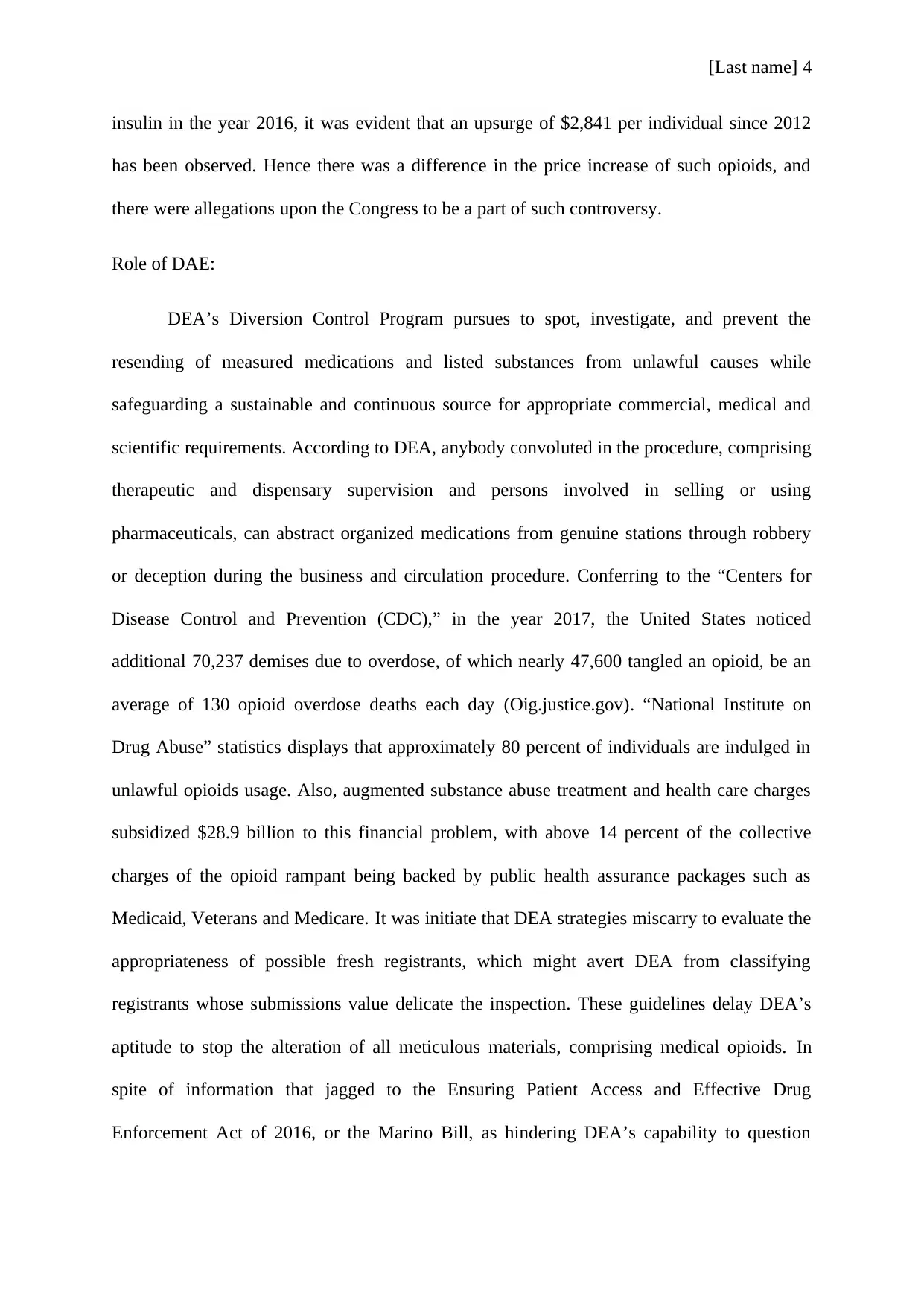
[Last name] 4
insulin in the year 2016, it was evident that an upsurge of $2,841 per individual since 2012
has been observed. Hence there was a difference in the price increase of such opioids, and
there were allegations upon the Congress to be a part of such controversy.
Role of DAE:
DEA’s Diversion Control Program pursues to spot, investigate, and prevent the
resending of measured medications and listed substances from unlawful causes while
safeguarding a sustainable and continuous source for appropriate commercial, medical and
scientific requirements. According to DEA, anybody convoluted in the procedure, comprising
therapeutic and dispensary supervision and persons involved in selling or using
pharmaceuticals, can abstract organized medications from genuine stations through robbery
or deception during the business and circulation procedure. Conferring to the “Centers for
Disease Control and Prevention (CDC),” in the year 2017, the United States noticed
additional 70,237 demises due to overdose, of which nearly 47,600 tangled an opioid, be an
average of 130 opioid overdose deaths each day (Oig.justice.gov). “National Institute on
Drug Abuse” statistics displays that approximately 80 percent of individuals are indulged in
unlawful opioids usage. Also, augmented substance abuse treatment and health care charges
subsidized $28.9 billion to this financial problem, with above “14 percent of the collective
charges of the opioid rampant being backed by public health assurance packages such as
Medicaid, Veterans and Medicare.” It was initiate that DEA strategies miscarry to evaluate the
appropriateness of possible fresh registrants, which might avert DEA from classifying
registrants whose submissions value delicate the inspection. These guidelines delay DEA’s
aptitude to stop the alteration of all meticulous materials, comprising medical opioids. “In
spite of information that jagged to the Ensuring Patient Access and Effective Drug
Enforcement Act of 2016, or the Marino Bill, as hindering DEA’s capability to question
insulin in the year 2016, it was evident that an upsurge of $2,841 per individual since 2012
has been observed. Hence there was a difference in the price increase of such opioids, and
there were allegations upon the Congress to be a part of such controversy.
Role of DAE:
DEA’s Diversion Control Program pursues to spot, investigate, and prevent the
resending of measured medications and listed substances from unlawful causes while
safeguarding a sustainable and continuous source for appropriate commercial, medical and
scientific requirements. According to DEA, anybody convoluted in the procedure, comprising
therapeutic and dispensary supervision and persons involved in selling or using
pharmaceuticals, can abstract organized medications from genuine stations through robbery
or deception during the business and circulation procedure. Conferring to the “Centers for
Disease Control and Prevention (CDC),” in the year 2017, the United States noticed
additional 70,237 demises due to overdose, of which nearly 47,600 tangled an opioid, be an
average of 130 opioid overdose deaths each day (Oig.justice.gov). “National Institute on
Drug Abuse” statistics displays that approximately 80 percent of individuals are indulged in
unlawful opioids usage. Also, augmented substance abuse treatment and health care charges
subsidized $28.9 billion to this financial problem, with above “14 percent of the collective
charges of the opioid rampant being backed by public health assurance packages such as
Medicaid, Veterans and Medicare.” It was initiate that DEA strategies miscarry to evaluate the
appropriateness of possible fresh registrants, which might avert DEA from classifying
registrants whose submissions value delicate the inspection. These guidelines delay DEA’s
aptitude to stop the alteration of all meticulous materials, comprising medical opioids. “In
spite of information that jagged to the Ensuring Patient Access and Effective Drug
Enforcement Act of 2016, or the Marino Bill, as hindering DEA’s capability to question
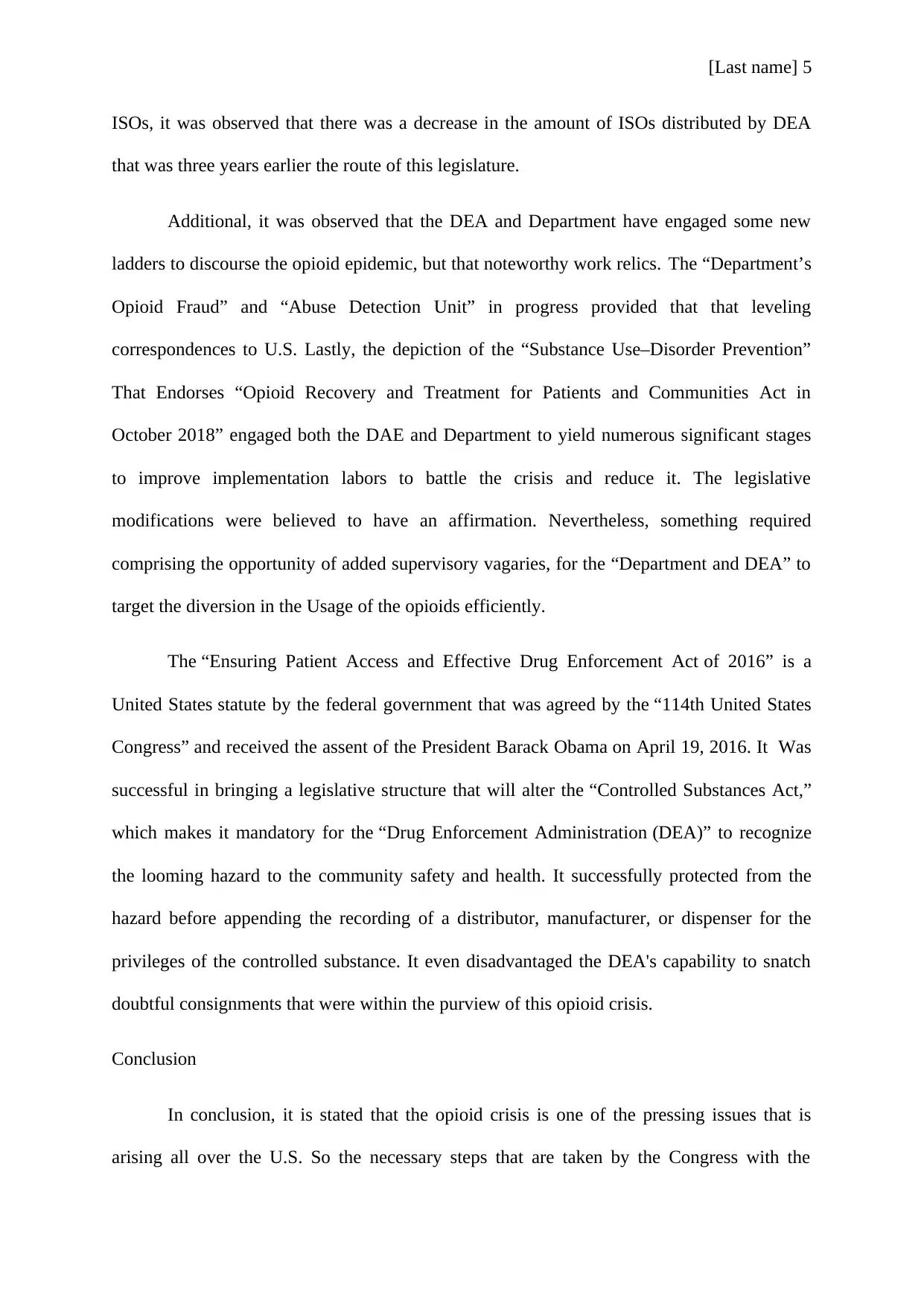
[Last name] 5
ISOs, it was observed that there was a decrease in the amount of ISOs distributed by DEA
that was three years earlier the route of this legislature.” “
Additional, it was observed that the DEA and Department have engaged some new
ladders to discourse the opioid epidemic, but that noteworthy work relics.” The “Department’s
Opioid Fraud” and “Abuse Detection Unit” in progress provided that that leveling
correspondences to U.S. Lastly, the depiction of the “Substance Use–Disorder Prevention”
That Endorses “Opioid Recovery and Treatment for Patients and Communities Act in
October 2018” engaged both the DAE and Department to yield numerous significant stages
to improve implementation labors to battle the crisis and reduce it. The legislative
modifications were believed to have an affirmation. Nevertheless, something required
comprising the opportunity of added supervisory vagaries, for the “Department and DEA” to
target the diversion in the Usage of the opioids efficiently.
The “Ensuring Patient Access and Effective Drug Enforcement Act of 2016” is a
United States statute by the federal government that was agreed by the “114th United States
Congress” and received the assent of the President Barack Obama on April 19, 2016. It Was
successful in bringing a legislative structure that will alter the “Controlled Substances Act,”
which makes it mandatory for the “Drug Enforcement Administration (DEA)” to recognize
the looming hazard to the community safety and health. It successfully protected from the
hazard before appending the recording of a distributor, manufacturer, or dispenser for the
privileges of the controlled substance. It even disadvantaged the DEA's capability to snatch
doubtful consignments that were within the purview of this opioid crisis.
Conclusion
In conclusion, it is stated that the opioid crisis is one of the pressing issues that is
arising all over the U.S. So the necessary steps that are taken by the Congress with the
ISOs, it was observed that there was a decrease in the amount of ISOs distributed by DEA
that was three years earlier the route of this legislature.” “
Additional, it was observed that the DEA and Department have engaged some new
ladders to discourse the opioid epidemic, but that noteworthy work relics.” The “Department’s
Opioid Fraud” and “Abuse Detection Unit” in progress provided that that leveling
correspondences to U.S. Lastly, the depiction of the “Substance Use–Disorder Prevention”
That Endorses “Opioid Recovery and Treatment for Patients and Communities Act in
October 2018” engaged both the DAE and Department to yield numerous significant stages
to improve implementation labors to battle the crisis and reduce it. The legislative
modifications were believed to have an affirmation. Nevertheless, something required
comprising the opportunity of added supervisory vagaries, for the “Department and DEA” to
target the diversion in the Usage of the opioids efficiently.
The “Ensuring Patient Access and Effective Drug Enforcement Act of 2016” is a
United States statute by the federal government that was agreed by the “114th United States
Congress” and received the assent of the President Barack Obama on April 19, 2016. It Was
successful in bringing a legislative structure that will alter the “Controlled Substances Act,”
which makes it mandatory for the “Drug Enforcement Administration (DEA)” to recognize
the looming hazard to the community safety and health. It successfully protected from the
hazard before appending the recording of a distributor, manufacturer, or dispenser for the
privileges of the controlled substance. It even disadvantaged the DEA's capability to snatch
doubtful consignments that were within the purview of this opioid crisis.
Conclusion
In conclusion, it is stated that the opioid crisis is one of the pressing issues that is
arising all over the U.S. So the necessary steps that are taken by the Congress with the
⊘ This is a preview!⊘
Do you want full access?
Subscribe today to unlock all pages.

Trusted by 1+ million students worldwide
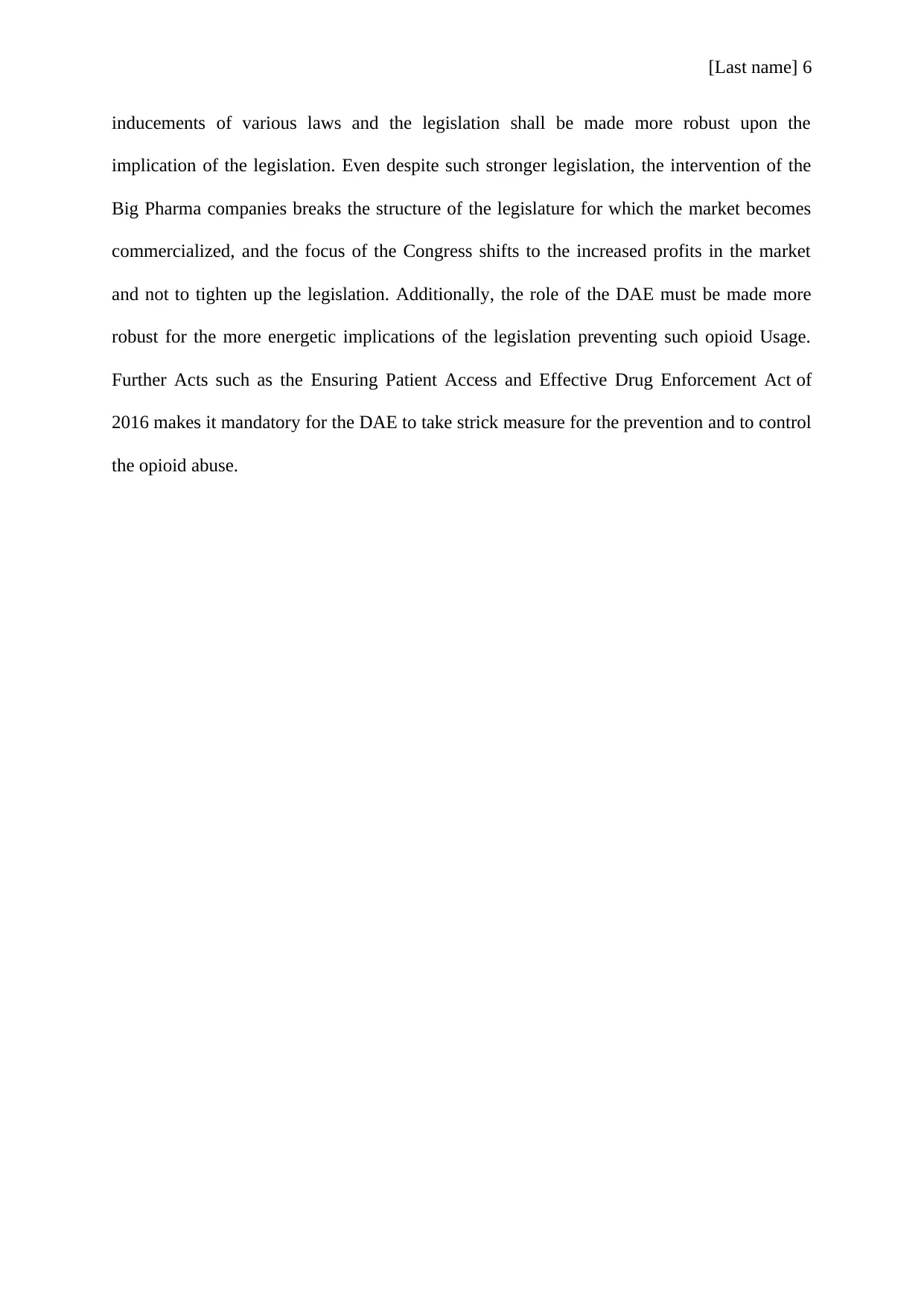
[Last name] 6
inducements of various laws and the legislation shall be made more robust upon the
implication of the legislation. Even despite such stronger legislation, the intervention of the
Big Pharma companies breaks the structure of the legislature for which the market becomes
commercialized, and the focus of the Congress shifts to the increased profits in the market
and not to tighten up the legislation. Additionally, the role of the DAE must be made more
robust for the more energetic implications of the legislation preventing such opioid Usage.
Further Acts such as the Ensuring Patient Access and Effective Drug Enforcement Act of
2016 makes it mandatory for the DAE to take strick measure for the prevention and to control
the opioid abuse.
inducements of various laws and the legislation shall be made more robust upon the
implication of the legislation. Even despite such stronger legislation, the intervention of the
Big Pharma companies breaks the structure of the legislature for which the market becomes
commercialized, and the focus of the Congress shifts to the increased profits in the market
and not to tighten up the legislation. Additionally, the role of the DAE must be made more
robust for the more energetic implications of the legislation preventing such opioid Usage.
Further Acts such as the Ensuring Patient Access and Effective Drug Enforcement Act of
2016 makes it mandatory for the DAE to take strick measure for the prevention and to control
the opioid abuse.
Paraphrase This Document
Need a fresh take? Get an instant paraphrase of this document with our AI Paraphraser
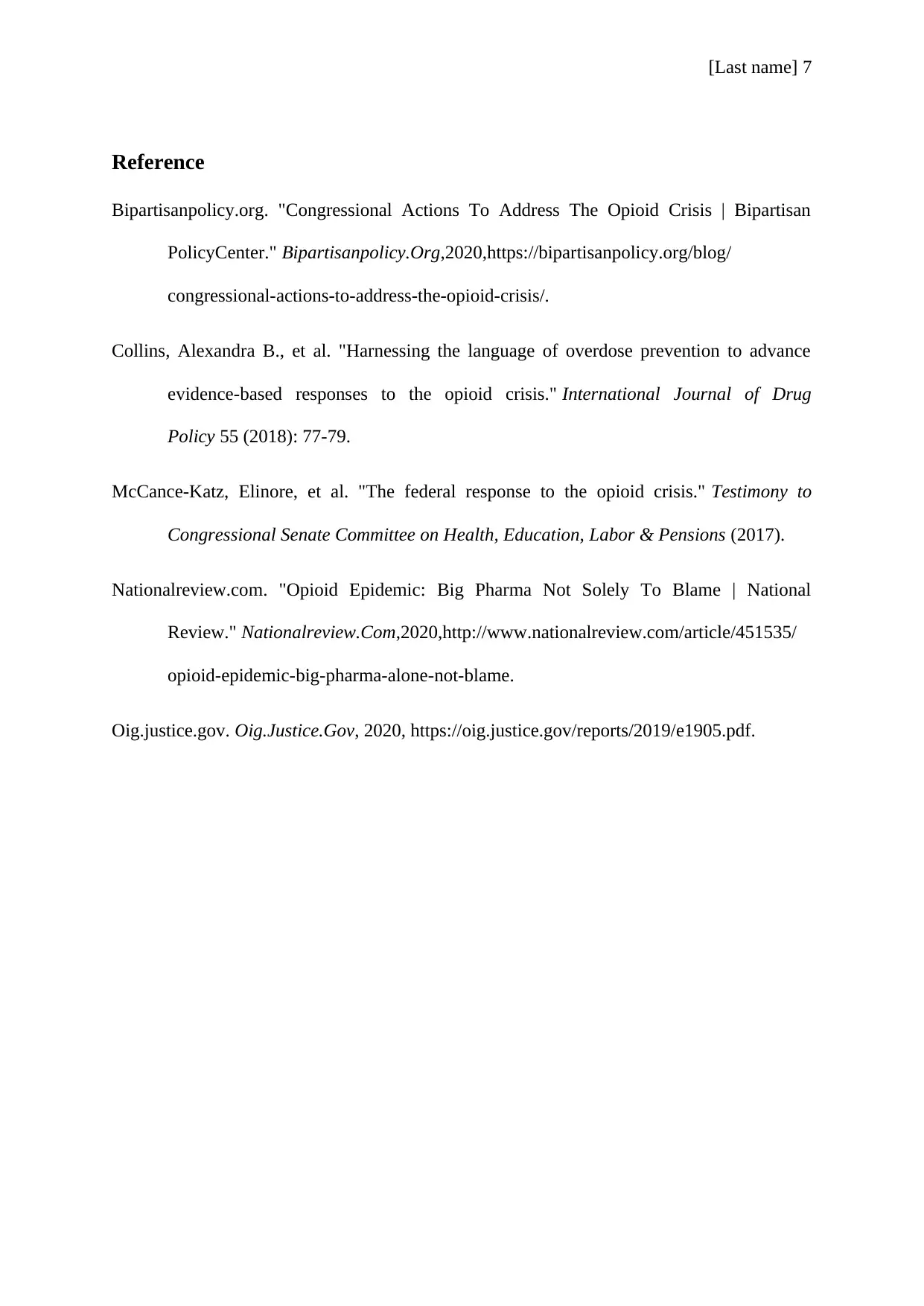
[Last name] 7
Reference
Bipartisanpolicy.org. "Congressional Actions To Address The Opioid Crisis | Bipartisan
PolicyCenter." Bipartisanpolicy.Org,2020,https://bipartisanpolicy.org/blog/
congressional-actions-to-address-the-opioid-crisis/.
Collins, Alexandra B., et al. "Harnessing the language of overdose prevention to advance
evidence-based responses to the opioid crisis." International Journal of Drug
Policy 55 (2018): 77-79.
McCance-Katz, Elinore, et al. "The federal response to the opioid crisis." Testimony to
Congressional Senate Committee on Health, Education, Labor & Pensions (2017).
Nationalreview.com. "Opioid Epidemic: Big Pharma Not Solely To Blame | National
Review." Nationalreview.Com,2020,http://www.nationalreview.com/article/451535/
opioid-epidemic-big-pharma-alone-not-blame.
Oig.justice.gov. Oig.Justice.Gov, 2020, https://oig.justice.gov/reports/2019/e1905.pdf.
Reference
Bipartisanpolicy.org. "Congressional Actions To Address The Opioid Crisis | Bipartisan
PolicyCenter." Bipartisanpolicy.Org,2020,https://bipartisanpolicy.org/blog/
congressional-actions-to-address-the-opioid-crisis/.
Collins, Alexandra B., et al. "Harnessing the language of overdose prevention to advance
evidence-based responses to the opioid crisis." International Journal of Drug
Policy 55 (2018): 77-79.
McCance-Katz, Elinore, et al. "The federal response to the opioid crisis." Testimony to
Congressional Senate Committee on Health, Education, Labor & Pensions (2017).
Nationalreview.com. "Opioid Epidemic: Big Pharma Not Solely To Blame | National
Review." Nationalreview.Com,2020,http://www.nationalreview.com/article/451535/
opioid-epidemic-big-pharma-alone-not-blame.
Oig.justice.gov. Oig.Justice.Gov, 2020, https://oig.justice.gov/reports/2019/e1905.pdf.
1 out of 8
Related Documents
Your All-in-One AI-Powered Toolkit for Academic Success.
+13062052269
info@desklib.com
Available 24*7 on WhatsApp / Email
![[object Object]](/_next/static/media/star-bottom.7253800d.svg)
Unlock your academic potential
Copyright © 2020–2025 A2Z Services. All Rights Reserved. Developed and managed by ZUCOL.





